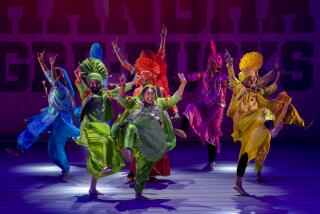Cultures Meet in the Sounds of Remember Shakti
- Share via
Jazz and Indian classical music have always seemed like natural partners. Both are improvisational, both base their improvisations upon material that provides a reference point for listeners, and both are driven by powerful rhythmic engines.
Guitarist John McLaughlin was an early advocate of exploring the connections between the two creative forms, and the original, mid-’70s manifestation of his group Shakti was an extraordinary effort to develop linkages that resulted in a kind of blended version of both musics. On Saturday night at UCLA’s Royce Hall, he revisited the group, with an unusually modified lineup and a new name, Remember Shakti.
Original member Zakir Hussain, a brilliant tabla player, was still present, with new members U. Shrinivas on mandolin (replacing L. Shankar’s violin) and V. Selvaganesh (the son of original member T.H. Vinayakram) on percussion.
The results, despite the interruption of a false fire alarm that precipitated a complete clearing of the auditorium after the first number, were superb, a convincing display of the manner in which jazz and Indian classical music can, indeed, come together.
For that to happen, however, certain requirements had to be met, and the first was that McLaughlin, as the only Westerner in the quartet and the key instrumentalist, had to have a thoroughly informed understanding of the immensely sophisticated elements of Indian music.
Aside from their similarities, jazz and Indian music differ primarily in the area of harmony, which has been historically vital to jazz, virtually nonexistent in Indian music. Rather than attempt to graft chordal structures onto the music of Shakti, McLaughlin has chosen to seek ragas--the blend of scales and melodies that are the improvisational basis of Indian music--similar to, sometimes identical to, Western scales. And, in several numbers, his choice of scales commonly used in the blues generated some striking results, especially in the exchanges between his guitar and Shrinivas’ mandolin. When he did introduce harmonies or chordal clusters, he did so in clear reference to the fundamental note--sometimes referred to as the drone--to which the percussion instruments were tuned.
Equally important, McLaughlin generally retained firm contact with the Indian system of rhythmic talas--essentially a repeated metric phrase--thereby allowing the percussionists to rove and interact freely, often with crowd-stirring, ecstatic results. And here too, his understanding of the subtleties of the Indian rhythmic style allowed him to solo in a fashion that convincingly combined rapid-fire Indian style with his own bebop-based roots.
It was, in sum, an inspired evening--the second impressive event at Royce (preceded by the Keith Jarrett trio performance on Thursday) in a week. Always a musical adventurer, McLaughlin’s return to Shakti--far from being a revisitation to the past--represents yet another compelling discovery in his ever-exploratory musical journey.
More to Read
The biggest entertainment stories
Get our big stories about Hollywood, film, television, music, arts, culture and more right in your inbox as soon as they publish.
You may occasionally receive promotional content from the Los Angeles Times.










